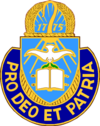Chaplain Corps (United States Army)
| United States Army Chaplain Corps |
|
|---|---|
|
United States Army Chaplain Corps
Branch Plaque |
|
| Active | 29 July 1775 – present |
| Country |
|
| Allegiance |
|
| Branch |
|
| Type | Corps |
| Role | Military Chaplaincy |
| Size | 2,700 |
| Motto(s) | "Pro Deo et Patria" (Latin: For God and Country) |
| Colors | Black |
| Engagements |
American Revolutionary War American Civil War Spanish–American War World War I World War II Korean War Vietnam War Gulf War Somali Civil War Kosovo War War in Afghanistan Iraq War |
| Website | Official Website |
| Commanders | |
| CCH | CH (MG) Paul K. Hurley |
| DCCH | CH (BG) Thomas L. Solhjem |
| Notable commanders |
CH (COL) John T. Axton CH (MG) William R. Arnold CH (MG) Francis L. Sampson CH (MG) Kermit D. Johnson CH (MG) Patrick J. Hessian CH (MG) Gaylord T. Gunhus |
| Insignia | |
| Branch Insignia |
  
|
| Distinctive Unit Insignia |  |
The Chaplain Corps of the United States Army consists of ordained clergy who are commissioned Army officers as well as enlisted soldiers who serve as assistants. Their purpose is to offer religious services, counseling, and moral support to the armed forces, whether in peacetime or at war.
The U.S. Army Chaplain Center and School (USACHCS) is part of the Armed Forces Chaplaincy Center (AFCC), which also includes the Air Force Chaplain Service Institute (AFCSI) and the U.S. Naval Chaplaincy School and Center (NCSC). The three schools are co-located at Fort Jackson, in Columbia, S.C.
In 2005, the Base Realignment and Closure Commission decided to put all military ministry training at the same location.
The purpose of the AFCC is to have closer cooperation among the three chaplain corps and to share instruction and training.
The U.S. Army Chaplain School was approved on 9 February 1918. Its first session began on 3 March 1918, at Fort Monroe, Virginia. Chaplain (MAJ) Aldred A. Pruden, who developed the plan for the school, was named the first commandant of the school. It subsequently moved to Camp Zachary Taylor (Kentucky), Camp Grant (Illinois), Fort Leavenworth (Kansas), Fort Benjamin Harrison (Indiana), Harvard University (Massachusetts), Fort Devens (Mass.), Fort Oglethorpe (Georgia), Carlisle Barracks (Pennsylvania), Fort Slocum (New York) (1951–62), Fort Hamilton (N.Y.) (1962–74), Fort Wadsworth (N.Y.) (1974–79), and Fort Monmouth (New Jersey) (1979–95).
...
Wikipedia

